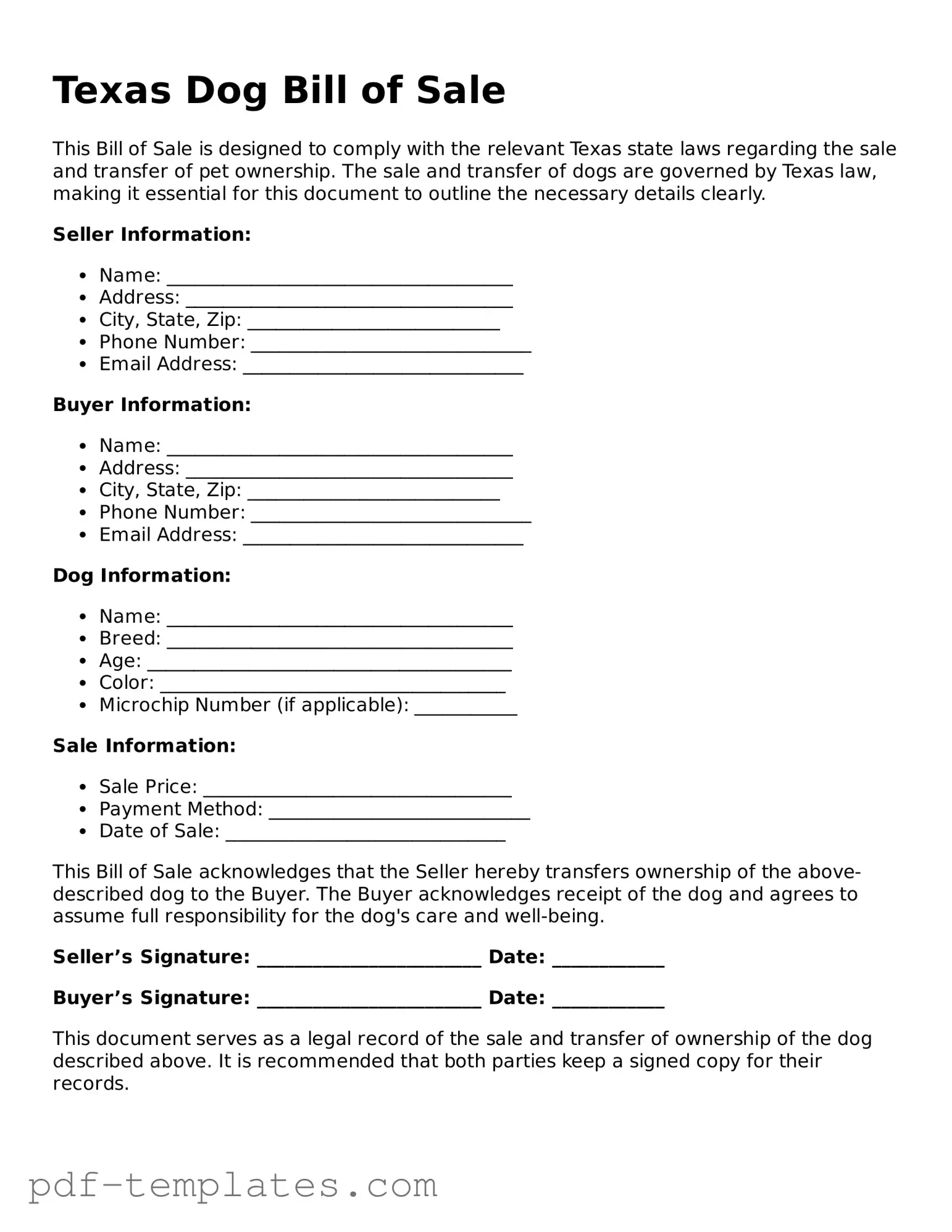The Texas Dog Bill of Sale form shares similarities with the general Bill of Sale, which is a document used to transfer ownership of personal property. Like the Dog Bill of Sale, a general Bill of Sale outlines the details of the transaction, including the identities of the buyer and seller, a description of the item being sold, and the agreed-upon purchase price. This document serves as proof of ownership transfer and can be essential for record-keeping and legal purposes, ensuring that both parties are clear about the terms of the sale.
Another document that resembles the Texas Dog Bill of Sale is the Pet Adoption Agreement. This agreement is often used by shelters and rescue organizations when placing animals in new homes. It typically includes similar elements, such as the adopter's information, a description of the pet, and the responsibilities of the adopter. Both documents emphasize the importance of responsible pet ownership and may include clauses regarding the animal's care and well-being, reinforcing the commitment being made by the new owner.
The Purchase Agreement for Pets is yet another document akin to the Dog Bill of Sale. This type of agreement is commonly utilized by breeders when selling puppies or kittens. It usually contains details about the animal, including breed, age, and health status, as well as the purchase price. Like the Dog Bill of Sale, it serves to legally bind the transaction and often includes warranties or guarantees regarding the pet’s health, ensuring that the buyer is informed and protected in their purchase.
A Texas Vehicle Purchase Agreement is essential when purchasing a vehicle, as it protects both the buyer and the seller by detailing the terms of sale. This document can be easily accessed at documentonline.org/blank-texas-vehicle-purchase-agreement/, providing crucial information on the sale price, vehicle details, and any warranties involved. Understanding this agreement ensures all parties are clear about their responsibilities and helps prevent disputes during the transaction.
A Lease Agreement for Pets can also be compared to the Dog Bill of Sale. While a Bill of Sale signifies ownership transfer, a Lease Agreement allows for the temporary use of a pet. This document outlines the terms of the lease, including duration, responsibilities for care, and any fees involved. Both documents aim to clarify the relationship between parties, but the Lease Agreement emphasizes the temporary nature of the arrangement, focusing on the obligations of the lessee in caring for the pet.
The Veterinary Release Form is another document similar to the Texas Dog Bill of Sale. This form is used when a pet owner allows a veterinarian to provide care for their animal. It includes information about the pet and the owner, similar to the Dog Bill of Sale, and requires the owner's consent for treatment. Both documents highlight the importance of responsible pet ownership and the necessity of proper care, ensuring that the pet's health is prioritized during the ownership transfer process.
The Animal Care Agreement is also comparable to the Dog Bill of Sale. This document outlines the responsibilities and expectations for pet care between parties, often used in situations involving shared ownership or pet sitting. It details the care requirements, feeding schedules, and other obligations. While the Dog Bill of Sale focuses on the transfer of ownership, the Animal Care Agreement emphasizes the ongoing responsibilities of pet care, ensuring that all parties are aligned in their commitment to the animal's well-being.
The Microchip Registration Form bears resemblance to the Dog Bill of Sale as well. This form is used to register a pet's microchip, which is essential for identification and recovery if the animal gets lost. Similar to the Dog Bill of Sale, it requires the owner's information and details about the pet. Both documents serve as vital tools for ensuring the safety and security of pets, emphasizing the owner's responsibility to keep their information current and accessible.
Lastly, the Pet Insurance Policy is another document that can be likened to the Texas Dog Bill of Sale. While the Dog Bill of Sale focuses on the transfer of ownership, a Pet Insurance Policy protects the financial interests of the pet owner in case of unexpected veterinary expenses. Both documents underscore the importance of being prepared for pet ownership responsibilities and ensuring the health and safety of the animal. They serve as reminders that responsible pet ownership extends beyond the initial purchase to include ongoing care and protection.
